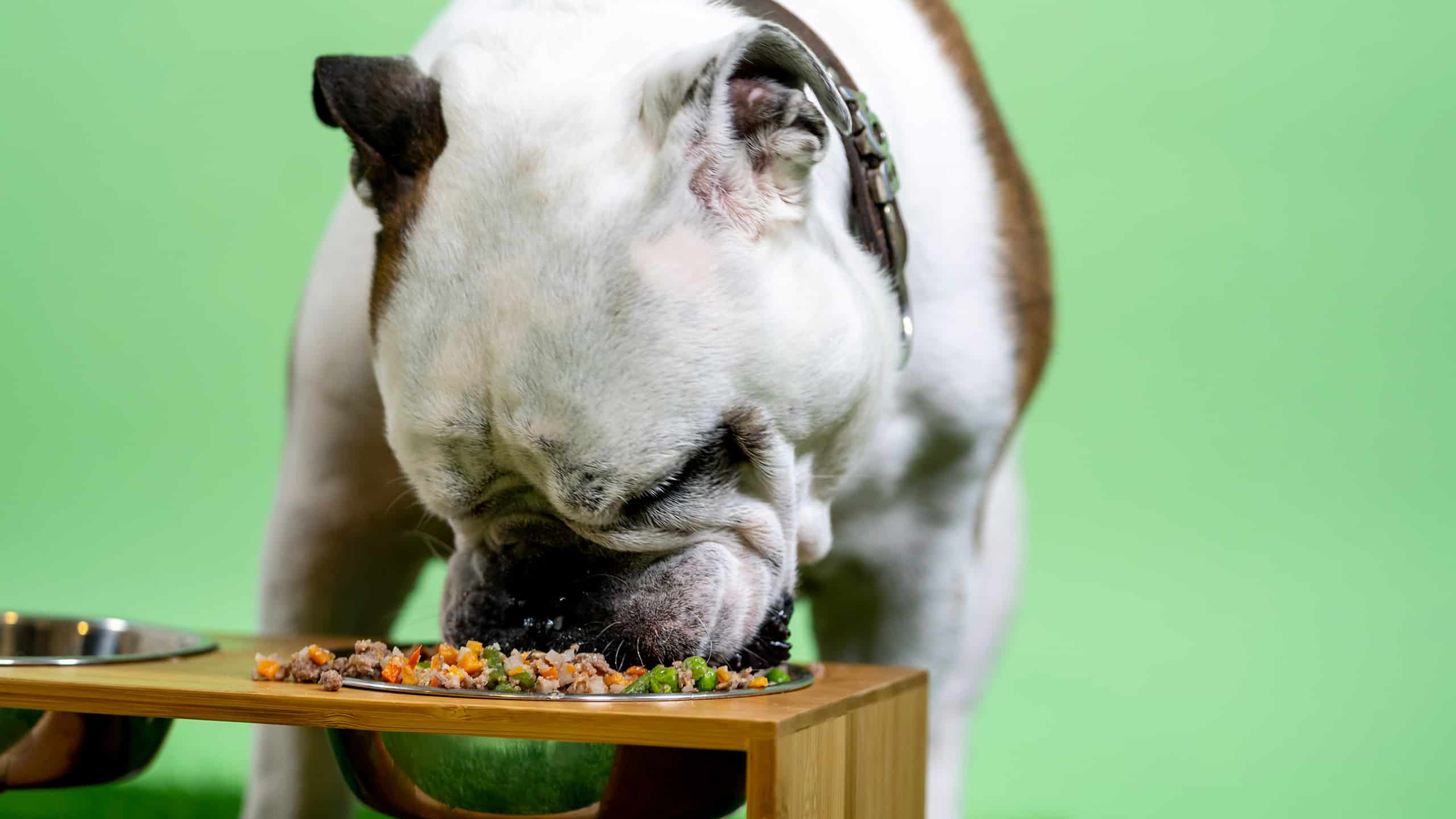Seeking a balanced diet for your dog that takes advantage of your crockpot? Our guide has you covered! By deciding to use your crockpot to cook homemade dog food, you gain control over what your furry friend eats – ensuring they get only the best from your kitchen.
Don’t forget yummy add-ons like a nice bone broth to drizzle over your new food.
Table of Contents
Key Takeaways
Making your own dog food at home means healthier ingredients that are tailored to their needs. You may also find it’s a cheaper alternative to the store-bought options.
A balanced diet for your dog should include a good mix of protein, vegetables, grains, and essential supplements like calcium and possibly fish oil or glucosamine.
Transition your dog gradually to homemade food to avoid digestive issues, and always consult your vet to ensure the home-cooked diet meets all their nutritional needs.
Benefits of Homemade Dog Food
As pet parents, we often worry about what goes into our fur babies’ meals. Nearly every month we see dog food recalls. This is both scary and frustrating since we can’t control how these products are produced.
This is where homemade dog food comes to the rescue. It offers the benefit of healthier ingredients, free from the preservatives and additives found in store-bought dog food. Likewise, it ensures that each ingredient is of the highest quality because we hand-pick it ourselves. Talk about control!
The best part? Your dog’s food is no longer a mystery. You know exactly what you’re putting in their bowls.
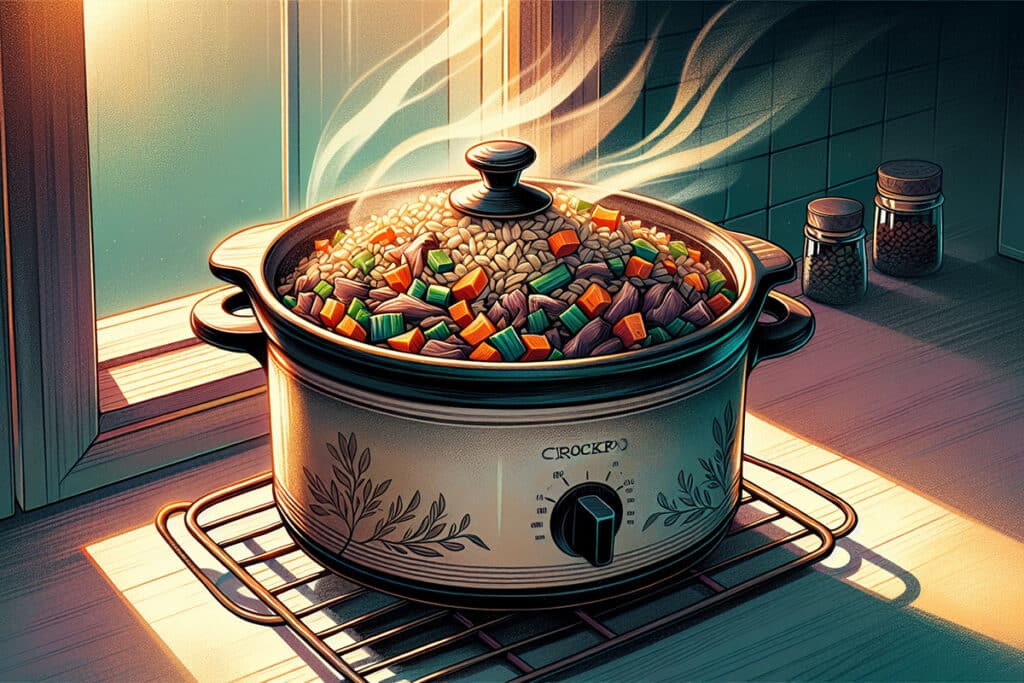
Healthier Ingredients
One of the biggest perks of home cooking for your dog is the ability to use fresh and wholesome ingredients. Homemade dog food can lead to better overall health for dogs by eliminating the fillers and additives frequently found in commercial dog foods. This means your dog gets to enjoy food that’s not only delicious but also packed with high-quality nutrients.
When you prepare your dog’s food at home, you’re in total control of the ingredients. You can avoid preservatives that are often found in commercial dog food. This is especially beneficial for dogs with allergies or sensitivities. No more worrying about unknown allergens or low-quality ingredients.
Plus, you can use the same ingredients you buy for your own meals. This way, you ensure your dog gets the best, just like the rest of your family. Buying in larger quantities should save you a bit of coin as well. Just make sure to watch out for the foods you should absolutely avoid like onions and garlic.
Customizable Recipes
Every dog is unique and so are their dietary needs. Homemade dog food allows for recipes to be tailored to the individual needs and preferences of your dog, such as specific health conditions, taste preferences, and dietary requirements.
You can adjust the ingredients and portions to suit your dog’s needs. Got a picky eater? You can experiment with different ingredients until you find the recipe your dog absolutely loves.
Consulting with a veterinarian or animal nutritionist before you start preparing your own dog food is a wise step. They can guide you in creating a diet for your pet that’s both homemade and nutritionally balanced. This helps ensure that your furry friend receives all the necessary nutrients in the correct amounts.
Despite the numerous advantages of homemade food, maintaining balanced nutrition can be tough. Certain diets, especially those that are grain-free or legume-based, have been linked to health issues such as dilated cardiomyopathy. Guidance from your vet can help you navigate these concerns and develop a healthy and safe diet plan for your pooch.
It is entirely possible that in order to get the right balance of nutrients, you may need to add supplements to your recipes. Dogs’ dietary needs are different from ours and hitting all the right vitamins and minerals can be difficult without supplementation.
Cost Savings
One of the misconceptions about home cooking for dogs is that it’s expensive. But did you know that preparing dog food at home can be more economical than purchasing commercial dog food? It’s true! By cooking your own dog food, you can often save money while providing high-quality meals for your furry friend.
Some homemade dog food recipes can cost under $2 per pound which is less than many of the “healthier” store-bought dog food options. Plus, you have the advantage of buying ingredients in bulk, which helps avoid the premium prices often associated with specialty commercial diets.
Keep in mind this is a process. At first, it may be a bit more expensive as you fine-tune your recipes, but in the long run, you should be able to get the cost down.
The cost of making homemade dog food, including necessary supplements like calcium and vitamins, can be as low as $3 a day. This offers some serious cost savings for pet owners. So, you can keep your dog healthy and your wallet happy!
Essential Ingredients for Your Dog’s Health
Having covered the advantages of homemade dog food, let’s dive into what you’ll need. A well-rounded pet diet should cater to their caloric intake and include an appropriate mix of proteins, fats, and carbohydrates, along with vital nutrients.
That sounds like a lot to track down! But don’t worry, we’ve compiled a list of necessary ingredients to put together your homemade crockpot dog food.
Protein Sources
Let’s start with protein, as it is a crucial part of your dog’s diet. Lean ground meats are a key component of protein in homemade dog food, contributing to the overall balance of essential nutrients.
You can use protein sources such as ground chicken, ground turkey, and ground beef in crockpot dog food recipes. Ground turkey is a commonly sourced protein for your pup, known for its lean quality and digestibility.
Also, proteins aren’t just about muscles. These meat sources contain essential fatty acids, vitamins, and minerals that are important to your dog’s health. So, whether it’s chicken, turkey, or beef, you’re providing your dog with a nutrient-rich base.
Now let’s add some veggies and grains.
Vegetables and Grains
Fresh vegetables and whole grains used in homemade dog food play a key role in providing essential nutrients and balance to your dog’s diet. By using a slow cooker, we can usually soften them which can make them easier to digest and absorb.
Some examples of vegetables and grains that are good for dogs include:
Carrots
Sweet potatoes
Green beans
Brown rice
Quinoa
Oats
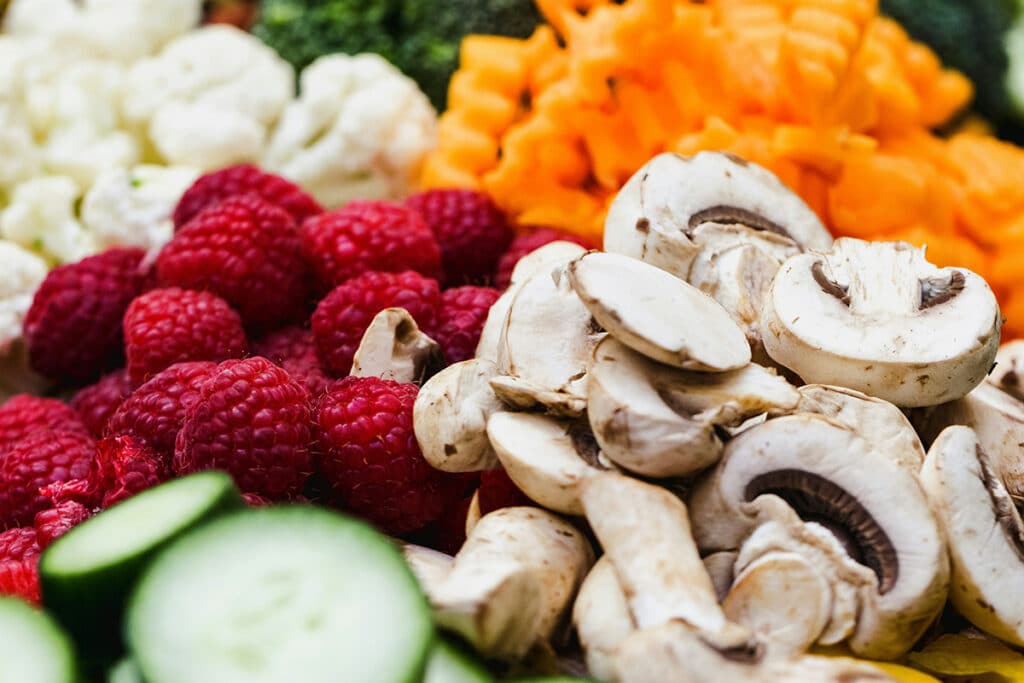
By incorporating these ingredients into your dog’s diet, you can ensure they are getting the necessary nutrients for optimal health. Check out our list of the best superfoods for pets to get some more ideas of what you can include.
Feel free to get creative and mix up the veggies and grains in your dog’s meals. Lastly, let’s talk supplements.
Supplements and Additives
Although proteins, vegetables, and grains make up the bulk of your dog’s food, we must not overlook certain supplements. Incorporating these is vital to providing your dog with a balanced and comprehensive diet.
Homemade dog food provides control over nutritional content but must be properly supplemented, particularly with calcium, which is often lacking in meat and vegetable ingredients. Supplements like fish oil can be added to your mix to support skin health and help reduce inflammation.
You can also use natural sources of certain supplements. For example, ground egg shells can be used as a natural supplement in homemade dog food to provide an essential source of calcium.
For older dogs or those with joint issues, supplements like glucosamine can be beneficial and can be included in their homemade diet.
Always consult your vet or nutritionist before adding any new supplements to your dog’s diet.
Step-by-Step Homemade Dog Food Crockpot Recipe
Having covered the advantages, vital ingredients, and required supplements, we can now move on to the exciting part – cooking!
We’re going to walk you through a step-by-step crockpot dog food recipe. This includes preparing ingredients, layering and cooking, and mixing and serving.
Let’s put that apron on and get started!
Preparing Ingredients
Before we start cooking, we need to prepare our ingredients. For this homemade crockpot dog food recipe, you’ll need your trusty crockpot and the following ingredients:
1 lb. ground turkey
1/2 bag frozen peas and carrots (or 1 cup fresh chopped carrots)
1 sweet potato
1 cup of spinach
2 cups organic brown rice
6 cups water and/or unsalted chicken or turkey stock
This is a good start for a single dog, but feel free to double or triple this up to the capacity of your slow cooker.
Remember, the quality of ingredients matters, so choose fresh and high-quality items when grocery shopping. Also, make sure to peel the sweet potato.
Evaluating the Cost of Our Ingredients
Based on the ingredients above, we broke down the cost to feed our own pack. We have six dogs, so what we prepared was used as an additive to half of their usual kibble over the course of 3 days, morning and night. That’s a lot of mileage without even doubling the recipe.
For reference, we have a Great Dane, two Standard Poodles, and three Rat Demons. Yes, that’s an official breed in our house – they’re all from the same litter and have Rat Terrier, Chihuahua, Papillon, among others in them. They’re crazy.
| Ingredient | Quantity Purchased | Unit Price | Quantity Used (% of purchase) | Cost Used |
|---|---|---|---|---|
| Ground Turkey | 1 pound | $5.99 | 1 pound (100%) | $5.99 |
| Organic Carrots | 5 pounds | $7.99 | 13 ounces (16.25%) | $1.30 |
| Sweet Potato | 11.2 ounces | $0.69 | 11.2 ounces (100%) | $0.69 |
| Spinach | 1 bunch | $2.99 | 1/2 bunch (50%) | $1.49 |
| Chicken Stock | 32 ounces | $3.79 | 32 ounces (100%) | $3.79 |
| Brown Rice | 32 ounces | $2.99 | 16 ounces (50%) | $1.49 |
| Totals | $14.75 |
As you can see, I ended up using organic carrots, not because I chose organic but it was the only bag of fresh carrots the store had that day.
Based on the price above, using it for three days across six dogs and two meals per day there is serious value. We will continue to use these sorts of meals as additive, but its easy to see that it would be a favorable cost comparison when put up against quality kibble.
Layering and Cooking
Now that our ingredients are ready, let’s dive into one of our slow cooker recipes. Here’s what you need to do:
Peel, chop, and prepare the vegetables. A food processor may help speed things up.
Brown the ground turkey and drain off any fat.
Place the ground meat in a single layer on the bottom of the crockpot.
Layer uncooked rice on top of the turkey.
Add frozen vegetables on top of the rice.
Pour water or stock over the ingredients until it reaches the top of the veggies.
Cook the crockpot dog food on a high setting for 5-6 hours or on a low setting for 8-10 hours, depending on the specific crockpot used. Check-in throughout the cook to see if you need to add any additional liquid. The last thing you’ll need to do is add the spinach with an hour or so remaining.
Mixing and Serving
Once the food is cooked, it’s time to serve it up!
But before we do that, it’s important to let it cool completely. This ensures it’s safe for your pet to eat because you know they’re going to be excited and dive right in!
After the dog food has cooled, give it a good mix to ensure all of the ingredients are equally distributed. Then, portion out the amount your dog typically eats at mealtime. Remember, every dog is different, so what’s perfect for one might be too much or too little for another.
Homemade dog food is different than dry kibble or canned food and your dog may not need the same amount they’re used to eating. Make sure to consult the right sources to determine how much you should serve.
Storing and Serving Meals
Just like with human food, proper storage of dog food is essential to maintain its freshness and prevent spoilage. Here are some tips for storing and serving your dog’s new meal.
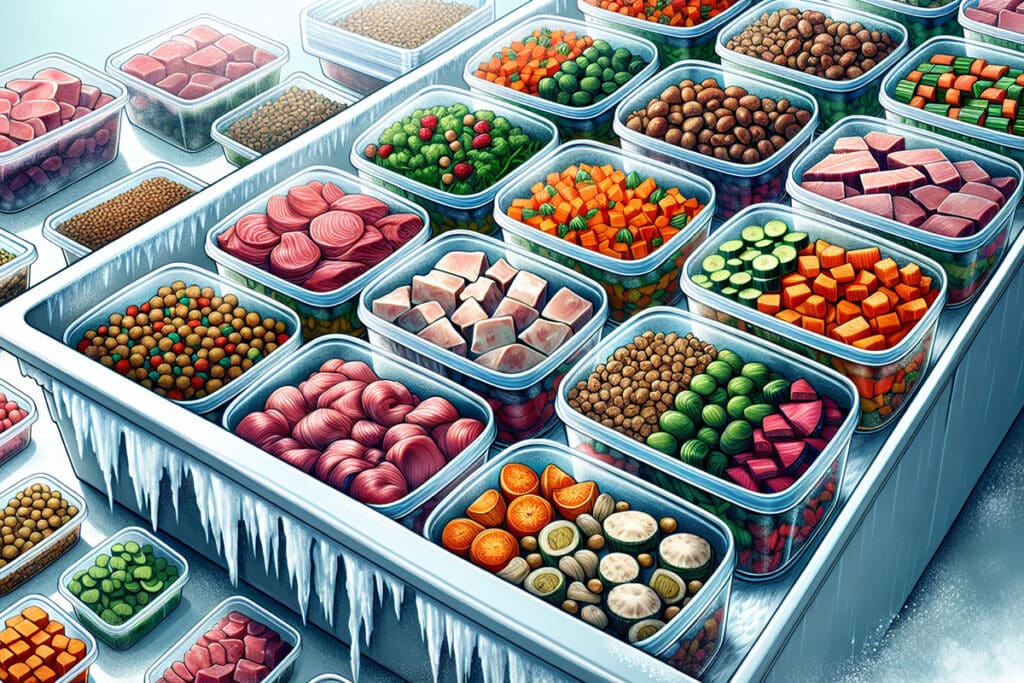
Storage Options
Once your food has thoroughly cooled, it’s ready for storage. It can be stored in airtight containers or bags in the refrigerator to maintain freshness. This is perfect if you plan to use it within a few days.
If you’ve made a larger batch, you can also freeze it for longer-term storage. It’s best to do this in single-serving portions. This way, you can simply defrost a serving overnight when you’re ready to use it.
For freezing, you can use plastic deli containers with airtight lids. These are great for easy stacking and space-efficient storage in your freezer.
Preparing large batches of homemade dog food and freezing it for future use is a smart strategy that saves both time and money.
Serving Suggestions
Come mealtime for your pet, you will need to thaw and warm up the food. Ideally, defrost it in the refrigerator overnight to ensure it’s ready to serve the next day. Alternatively, a microwave defrost cycle can do the trick in a pinch.
Reheating defrosted dog food can be done either in the microwave or on the stovetop until it reaches a hot enough temp without burning. After cooking, just make sure that the food has cooled enough to be safely consumed by your pet.
Serving homemade dog food is not just about nutrition, it’s also an opportunity to bond with your pet. Make mealtime a special time of the day that your dog looks forward to. After all, there’s nothing quite like seeing your dog’s tail wag in anticipation of a delicious meal, made with love by you!
Transitioning Your Dog from Commercial to Homemade Food
Switching your dog’s diet from commercial to homemade food should be a gradual process. A sudden change could lead to digestive disruptions.
Here are some tips to facilitate a smoother transition.
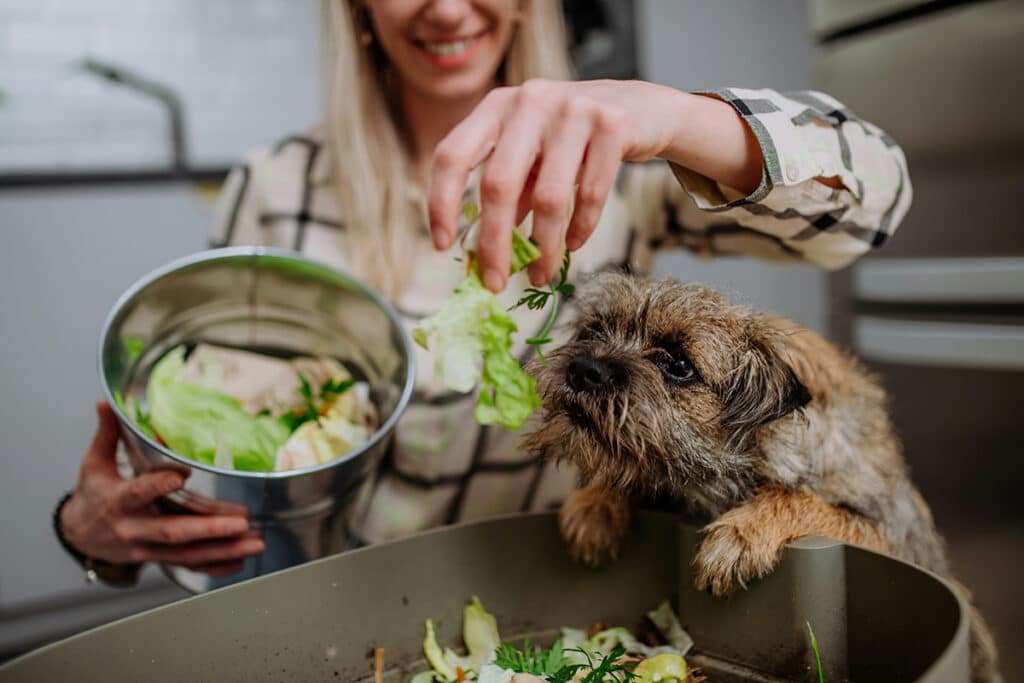
Introducing New Food
The introduction of homemade dog food should be done gradually to ease the transition. Start by combining it with your dog’s current commercial food. On the first day of transitioning, mix 20% of the new homemade food with 80% of their existing commercial diet.
Over five days, gradually modify the ratio of homemade to commercial food, by exchanging 20% of the store-bought food for your homemade food until you reach 100% pure crockpot goodness.
If at any point your dog shows intolerance to the new diet, revert to the original food and consult a veterinarian or nutritionist for guidance.
Monitoring Your Dog’s Reaction
It’s imperative to keep a close eye on your dog’s behavior and energy levels for any notable changes during the transition to homemade food, especially for those with sensitive stomachs. This could indicate an issue with the new diet and may require adjusting the transition pace, additional supplementation, or something else entirely.
Be mindful of signs of digestive upset such as vomiting, diarrhea, or changes in stool consistency. These are important indicators of how well your dog is adjusting to the homemade diet.
Regular discussions with a veterinarian about your dog’s diet and reaction to the new recipe are essential to managing and optimizing your pet’s diet and transition.
Periodic veterinary examinations and tests can help in the early detection of any problems that may arise from dietary changes, allowing for timely adjustments before they become more serious issues.
Remember, the goal is to enhance your dog’s health and happiness with homemade food, so close monitoring during the transition phase is key.
Consult Your Veterinarian or Nutritionist for Advice
Professional advice is indispensable for your pet’s health and well-being. Before changing your dog’s diet to homemade food, it’s necessary to consult with a veterinarian or pet nutritionist.
They can check for potential allergies and confirm whether the recipe suits your dog’s specific dietary needs.
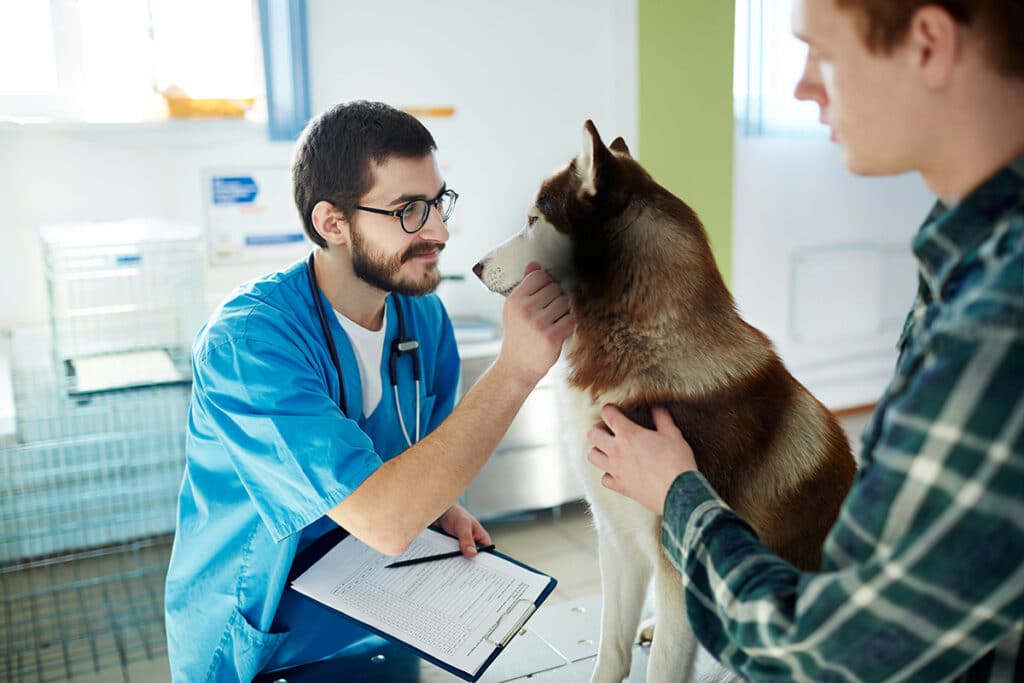
Let’s explore this further.
Discussing Pet’s Needs
As we already mentioned, each dog is unique and so are their nutritional requirements. Your vet or nutritionist can help tailor homemade dog food recipes to meet these needs effectively. This will ensure your homemade food delivers the right nutrients in the right proportions.
Experts may also suggest you include a multivitamin to supplement your dog’s diet to ensure they receive all necessary nutrients.
So, before you start making your own dog food, make sure to have a comprehensive discussion with your vet or nutritionist about your dog’s specific situation.
Recommended Supplements
Supplements can be pivotal in providing your dog with a balanced and comprehensive diet.
Nonetheless, when considering supplements for homemade dog food, it’s crucial to seek advice from a veterinarian or a veterinary nutritionist.
Veterinarians are equipped to determine the correct supplements needed to round out homemade dog food, ensuring your dog receives complete nutrition. Professional guidance ensures that the homemade diet meets all of the dog’s nutritional requirements.
So, before you add any supplements to your dog’s food, make sure to consult your chosen expert.
Summary
In conclusion, making homemade dog food for your dog is not just a labor of love, but also a commitment to their health and well-being. From the benefits of healthier ingredients and customizable recipes to cost savings, the advantages of homemade dog food are clear.
However, it’s crucial to consult with a vet or nutritionist, ensure a balanced diet, and make the transition gradually.
With these steps, you’re on your way to providing your beloved pet with nutritious and delicious meals they’ll love. And don’t forget, you can take a bite as well!
Frequently Asked Questions
Can dogs eat beef stew?
No, dogs should not eat beef stew as it may lead to nutrient imbalances or deficiencies over time. Additionally, some ingredients in beef stew that are safe for humans can be harmful or toxic to dogs, such as onions.
Is homemade dog food better than store-bought?
Yes, homemade dog food can be better than store-bought because it allows you to control the quality of ingredients, but you should ensure it is nutritionally balanced.
What are the essential ingredients for homemade dog food?
To make homemade dog food, you’ll need proteins like lean ground meats, carbohydrates from vegetables and grains, and essential nutrients like calcium and fish oil to balance their diet.
How do I transition my dog to homemade food?
To transition your dog to homemade food, start by mixing a small amount with their current commercial food, then gradually increase the homemade portion over five days while decreasing the commercial portion. This will help your dog adjust to the new diet without causing digestive issues.
How do I store homemade dog food?
You can store homemade dog food in airtight containers in the refrigerator or portion it out and freeze it for longer storage. It’s important to keep it fresh for your furry friend!
